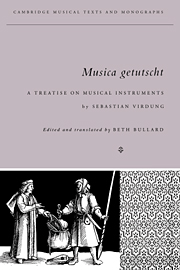Book contents
- Frontmatter
- Contents
- Preface
- List of abbrevations
- PART I TRANSLATOR'S INTRODUCTION
- 1 Why study Musica getutscht?
- 2 A biography of Sebastian Virdung
- 3 The publication history of Musica getutscht
- 4 The offspring of Musica getutscht
- PART II MUSICA GETUTSCHT
- Appendix Transcriptions of documents pertaining to Sebastian Virdung and Musica getutscht
- Notes
- Bibliography
- Index
2 - A biography of Sebastian Virdung
Published online by Cambridge University Press: 14 August 2009
- Frontmatter
- Contents
- Preface
- List of abbrevations
- PART I TRANSLATOR'S INTRODUCTION
- 1 Why study Musica getutscht?
- 2 A biography of Sebastian Virdung
- 3 The publication history of Musica getutscht
- 4 The offspring of Musica getutscht
- PART II MUSICA GETUTSCHT
- Appendix Transcriptions of documents pertaining to Sebastian Virdung and Musica getutscht
- Notes
- Bibliography
- Index
Summary
The name Sebastian Virdung would, no doubt, have remained within the darkest shadows of recorded history had he not produced the little work on the musical instruments of his era, Musica getutscht. With information gleaned from surviving documents (listed and translated below, pp. 34–46), we can piece together a fragmentary biography and a not altogether flattering picture of the man. Very little is known about the early and final years of his life. A birth date no later than 1465 can be postulated on the basis of his appointment in April 1489 to a position reserved for clergymen past the age of twenty-four (document no. 3). Presumably his birth took place in Amberg (then capital of the Upper Palatinate) because most of the extant documents relating to his activities style him “Sebastian from Amberg.” This, however, is by no means certain, especially since his father, Wenzel Virdung, achieved the status of a burgher there only in 1475 (doc. no. 23), when Sebastian would have to have been at least ten years old. Although our author retained the surname Virdung, his father had acquired the name Grop in 1468, when Emperor Frederick III presented to him a coat of arms with that name – the last male members of the family that had previously carried the name having died (doc. no. 22).
Virdung matriculated at the University of Heidelberg in 1483 at about the age of eighteen (doc. no. 1).
- Type
- Chapter
- Information
- Musica GetutschtA Treatise on Musical Instruments (1511) by Sebastian Virdung, pp. 25 - 46Publisher: Cambridge University PressPrint publication year: 1993



